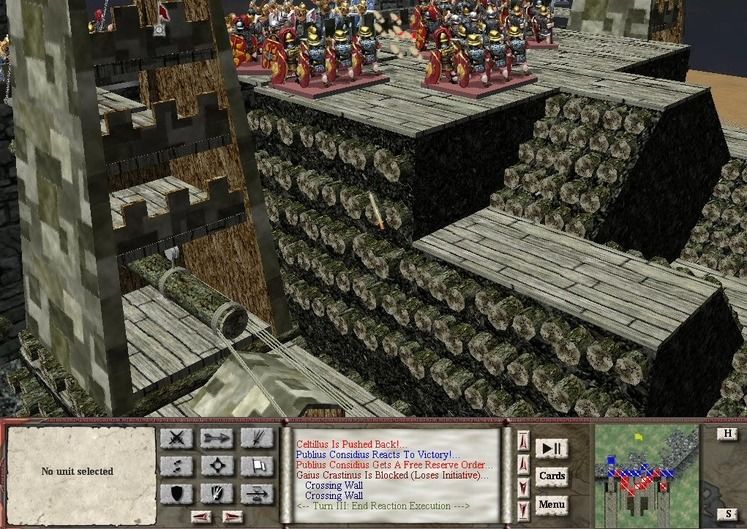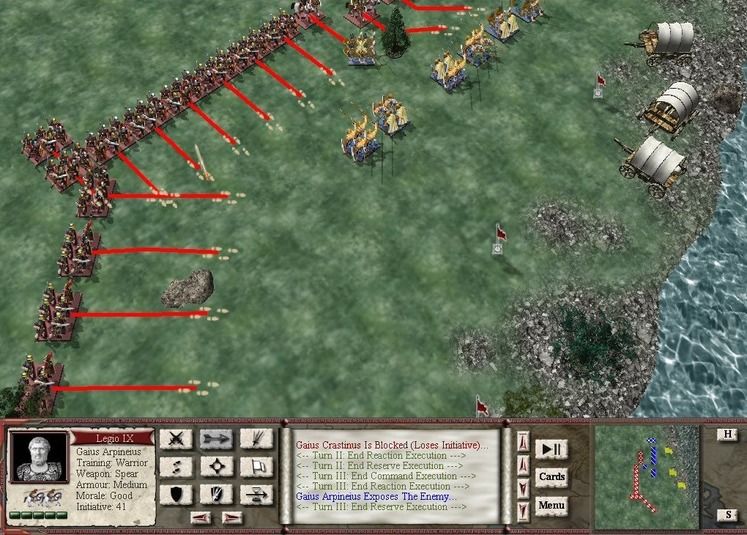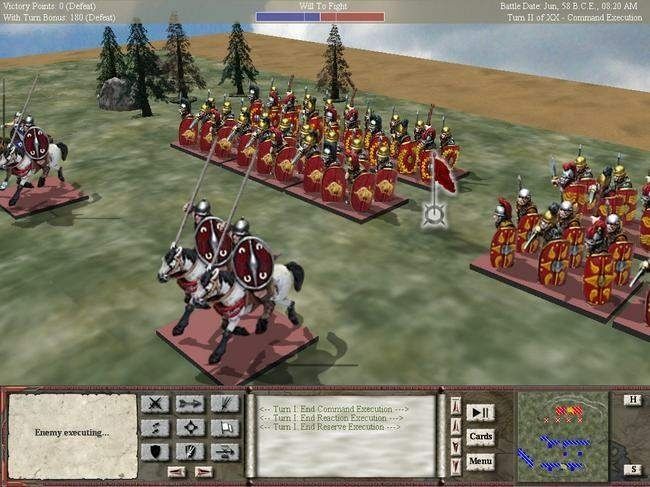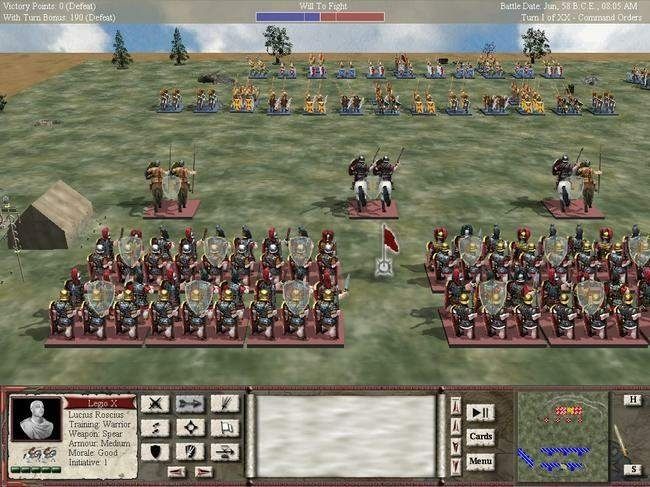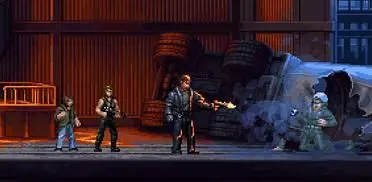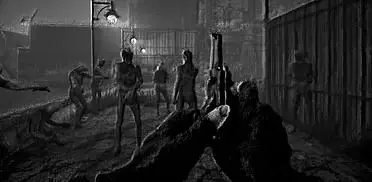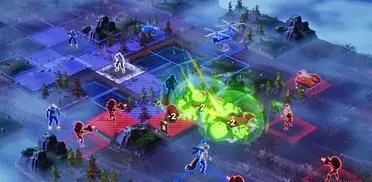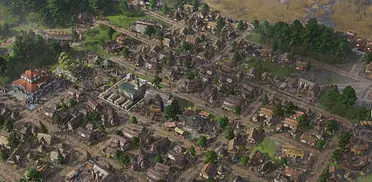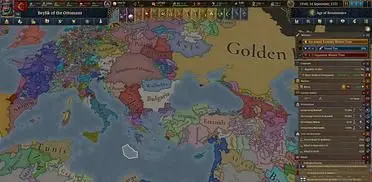Si: Could you tell us about yourself.
Koios Works: Koios Works is an independent studio based in Dallas Texas. We have five full time staff members. All of our team spent years working in traditional commercial software development and made the leap to gaming when we launched the studio.
Si: The "Tin Soldiers" series brought an innovative turn based system to daylight. Could you describe it briefly for people who dont know the series?
Koios Works: Many players like turn based games because they have time to think and plan. In most turn-based games players alternate moving their units or pieces – either by moving one piece (e.g. Chess) or moving all their pieces (e.g. Civilization/Risk) against their opponent and then the opponent responds by moving a unit or all his units. This approach has a couple of problems. First, the ‘non-moving’ player can get bored while waiting for his opponent to do his turn. Second, it tends to yield unrealistic play as the ‘phasing’ player can launch attacks and overwhelm the opponent who can’t do anything until their ‘turn’. Many gamers like real time strategy games because they are fast paced and exciting. On the other hand, real time strategy games (RTS) can tend to be too frantic and degenerate into who is the better micro manager instead of who is the better general. Tin Soldiers is taking and blending the best of both turn based and RTS games. Our game is like an RTS game in that both players are ‘thinking and ordering’ at the same time but it is like a turn based game because ordering units and execution of those orders take place in distinct turns so the game paces like a turn based game . In a given ‘turn’ both players simultaneously give orders to all of their units. Each turn represents 15 minutes of ‘game world’ time. After both players have issued their orders to all of their units and press a play button, all units simultaneously move and execute their commands. But, unlike RTS games, the players do not have the luxury of immediately taking back mistakes as their army is committed to its strategy until the next turn. However, this is where the reaction system comes into play. Individual units, based upon battlefield conditions, may receive a ‘reaction’ order. This will pause the execution, and allow the player to give this unit a new order that will take place for the remainder of the turn. For example, an archer might be given an order to fire arrows at an enemy unit during the turn. But, as the turn executes, an enemy cavalry starts to charge toward the archer. Well, that archer unit might receive a reaction order that will pause the game. The player would then have the opportunity to order the archer unit to retreat. We believe that our game really merges the best attributes of turn based and real time strategy while removing many of the disadvantages of the two mechanisms.
Si: "Tin Soldiers: Julius Caesar" is a sequel of the successful "Tin Soldiers: Alexander the Great". What are the changes, beside of course another times and armies involved?
Koios Works: We have really upgraded our terrain graphics. In Caesar you can rotate, pan and zoom the camera all around the map. We have also decided to go for a more traditional texturing of the terrain itself. In Alexander we purposely made the terrain a bit grainy so that it would appear to be made out of composite material (like a toy train set). However, some people did not like the poor contrast of this look. In Caesar, the terrain is much more blended and smooth. This is giving the units really nice contrast. For game play we now have unit formations (i.e., Legion X is three units) and the legion units are six stands. We have also implemented siege weapons and walls that actually impact defense. There are also 14 battles in the campaign. The campaign has three distinct phases: Gaul, Alesia, and the Civil War.
Si: When I look on the battlefield in "Tin Soldiers" it reminds me of miniature games. Wasn't it an attempt to put a well designed miniature game onto a computer?
Koios Works: We wanted a game that had the majestic look of a museum quality miniatures display and that was faithful to table top gaming. However, we really wanted game play to be more similar to games such as Panzer General than to De Bellis Antiquitatis (DBA) rules.
Si: Psychology of units is very important aspect in miniature games. Does it play such a significant aspect here as well?
Koios Works: We implemented a host of morale rules. Each unit has morale and this morale really impacts combat effectiveness. We also have ‘waterfall’ morale rules, meaning that units are impacted by events around them. For instance, if a heroic commander is killed, friendly units all over the battlefield must pass a morale check; or, if a unit routs, all units that are near the routing unit most check morale. However, unlike real ancient battles and the typical rules of ancient miniatures, we made morale secondary to damage. Ancient battles had surprisingly few casualties. Most death came after an army broke and fled the battle (fleeing units were brutally chased down). That is why you see historical accounts of battles where the winning side lost 800 men while the losing side lost 10,000 men. Most miniature rules therefore are all about breaking morale and you get a strong domino effect with full strength units breaking and fleeing to win the battles. We choose to go with a more damage based approach because we think it’s simply more fun to kill on the battlefield than after the fact.
Si: The structure of a historic legion was very strict. Consisting of 4800 armed men. Is it implemented in the game? And if/if not does the player have the ability to choose what type of units he wants in his army?
Koios Works: As mentioned in an earlier response, one of the new features in Caesar is the addition of unit formation. Each legion consists of three stands (six units each) of swordsmen and one attached cavalry regiment. Legions also get the limited ability to use their pilum as missile fire weapons. During the campaign, the player decides which legions to mobilize for the upcoming battles. Also, it is much harder to replace dead stands in Caesar (in Roman times, the legions tended to dwindle until a new re-enlistment). So, players must now think in terms of rotating forces between battles.
Si: How many unit types are there and how do they differ? Any special bonuses when one type fights another?
Koios Works: One of the biggest differences between Alexander and Caesar is the importance of spearmen phalanx compared to swordsmen. In Alexander’s time, the long pike (spearmen) phalanx’s ruled the battlefield. The Romans pioneered the use of the thrown pilum and short sword that was the perfect anti phalanx formation. So, in Caesar, swordsmen are predominating over spearmen - the opposite of Alexander. We have also added siege weapons, both catapults and scorpions – very strong but fragile missile platforms.
Si: When you are a commander you must try to save people for future battles. Do army losses carry over to the next battle in a campaign and can one replace them?
Koios Works: Yes, and this is an important part of game play. For instance, in the Gallic War, Caesar has six legions available to him. The player chooses which legions to bring into battle. Some battles might only require two legions, some all six. Losses are carried forward and are much more expensive to replace than they were in Alexander. However, loses will slowly replenish for ‘free’ if the player lets a legion rest between battles.
Si: I read something about special cards, what are they?
Koios Works: The same strategy cards that were in Alexander make their appearance in Caesar. These are special one time use ‘power ups’ that can give your troops an edge in battle. For example, the legions can assume ‘turtle formation’ and gain a +1 to defense for an entire turn.
Si: What if you lose one battle? Does it make you lose the war?
Koios Works: If you lose a battle the campaign does not end. Caesar lost the battle at Gergovia. However, to progress in the campaign, the player must gain prestige. Prestige is only awarded for victory. Players can choose to re-fight battles they lost if they need more prestige to continue.
Si: Any multiplayer available?
Koios Works: We are finalizing our plans for multiplayer. Our current plan is to support TCP/IP head to head play.
Si: Are there plans for another "Tin Soldiers"?
Koios Works: We would like to continue the series but that all depends on if we sell enough of Alexander and Caesar to fund development.
